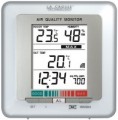This function lies in the fact that the thermometer "evaluates" the surrounding conditions — how comfortable they are for a person — and displays the result on a scale. It can be implemented in different ways, depending on the purpose (see above).
So, in models for water, additional marks on the scale are used — “Cold”, “Hot”, “Optimal” (for bathing a child); it is much easier to assess the temperature of water on them than on a scale with degrees. In domestic electronic models (see "Type"), the comfort is often determined by a combination of temperature and humidity. And in models with the possibility of external measurements,
the comfort temperature can mean the perceived temperature. The meaning of this indicator is that at high humidity, both heat and cold are felt more acutely — as if it is hotter or colder outside than it really is. Some thermometers are able to estimate what temperature will correspond to the sensations of a person who went outside; This allows you to dress for the weather.
—
Display backlight. The backlight feature enables reading the display in low light or darkness. Typically activated by pressing a button and deactivated upon release, this design minimizes energy consumption. However, some devices may keep the backlight on continuously for decorative purposes.
—
Clock. Clocks that show the current time vary in dial type and functionality based on the thermometer type mentioned earlier. Electronic models use digital displays with added features, while mechanical thermometers typically feature traditional arrow dials. Some of these mechanical models even resemble watches with an integrated thermometer, emphasizing the thermometer aspect rather than the clock.
—
Alarm clock. Possibility of giving a sound signal at a certain time set by the user. An alarm clock can be used not only for getting up in the morning, but also for any reminders associated with a specific time — for example, as an impromptu replacement for a kitchen timer. This feature, by definition, requires a clock (see above).
—
Calendar. The presence of a calendar implies at least the display of the current date on the thermometer (day of the month, often the month, less often the year). In addition, electronic models may provide viewing the year by month. The calendar can be used not only by itself, but also fo
...r other functions — for example, fixing min / max temperature moments (see above).
— Moon calendar. This function provides a display of the current phase of the moon, and in most cases also allows you to determine the days of new moons and full moons. Auspicious moments for many types of human activities (cosmetic procedures, treatment, gardening) are directly dependent on the phases of the moon. This feature assumes a regular calendar (see above).
— Synchronization with smartphone. The ability to remotely connect to the device using a mobile phone (tablet) allows you to remotely monitor weather conditions and read all information from sensors.
